April 17, 2025 | 06:15 GMT +7
April 17, 2025 | 06:15 GMT +7
Hotline: 0913.378.918
April 17, 2025 | 06:15 GMT +7
Hotline: 0913.378.918
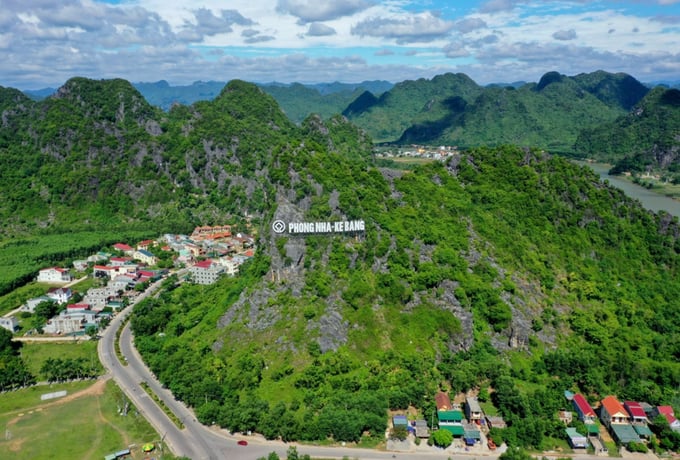
The beautiful scenery of Phong Nha - Ke Bang National Park. Photo: PN.KB.
I had the opportunity to view the famous mountains and forests from above with Mr. Pham Hong Thai, Director of the Management Board of Phong Nha - Ke Bang National Park. The mountains and forests are intertwined like an enchanting picture. "More charming scenes await tourists at the heart of the heritage," Mr. Thai said.
The United Nations Educational, Scientific and Cultural Organization (UNESCO) has recognized Phong Nha - Ke Bang in Quang Binh province as a World Natural Heritage since 2003. In 2015, UNESCO honored the World Natural Heritage a second time for meeting the criteria of ecosystem and biodiversity.
Over the years, major international news agencies including The New York Times, The Guardian, The Mirror, The Huffington Post and more than 50 magazines around the world have continuously published articles of praise.
Phong Nha - Ke Bang National Park is located in the northwest region of Quang Binh province, along the Vietnam - Laos border. The park has a central area of over 123,300 hectares and nearly 217,700 hectares of buffer zone. The park spans across 13 communes in 3 districts of Minh Hoa, Bo Trach and Quang Ninh.
Phong Nha - Ke Bang evokes an image of limestone mountains that overlap one another. Viewed from above, the limestone mountains form a vertical shape; up close, the shape changes to that of an ancient Roman citadel. The Phong Nha limestone massif located on the majestic Truong Son mountain range is estimated to be 10,000 km2 in size, making it the largest in the Indochina peninsula. According to scientists, more than 460 million years ago, giant hills at the bottom of the ocean transformed into a unique landscape for the Phong Nha - Ke Bang National Park.
Calcium and carbon found in marine shells are two dissolved minerals that when combined naturally with seawater, a new mineral called calcium carbonate is formed. The geological tectonics of the earth's crust pushed these sediments over millions of years to rise from the seabed and form towering limestone mountains in Phong Nha.
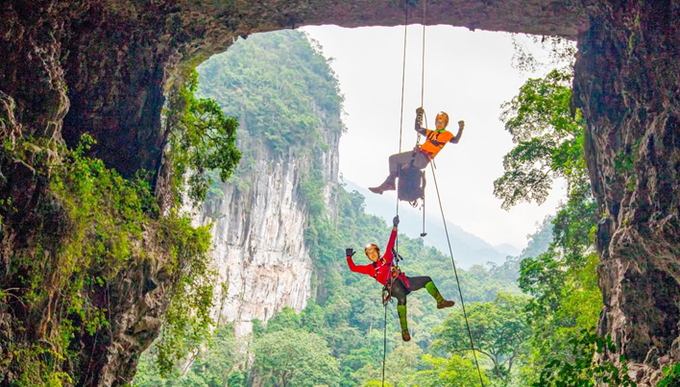
Son Doong cave - the largest natural cave on Earth. Photo: PN-KB.
Rainwater seeps into the crevices of limestone and flows downward due to gravity until it meets the lower sedimentary layer. This process continues ceaselessly, causing the crevices to become wider and forming giant caves. The water flow left behind minerals after encountering obstacles in the circulation process.
Mr. Pham Hong Thai explained: “Scientists have confirmed that this continuous process has created large and small stalactites of varying shapes. All of these stalactites gradually create magnificent wonders such as Son Doong cave, Tiger cave system, Phong Nha wet cave, Thien Duong dry cave, En cave and so on. British explorers have found caves of varying sizes that were the products of this natural process. As a result, Phong Nha - Ke Bang National Park was named the "Kingdom of Caves".
So far, the total number of caves in Phong Nha - Ke Bang remains unknown. Surveying experts have reported as many as 500 caves by 2023. All of these are magnificent and contain stalactite sculptures created by nature's magical hand, ready to captivate explorers who are willing for adventure.
According to Mr. Pham Hong Thai, a new discovery recently "shocked" biologists when a previously presumed extinct animal was found in Phong Nha - Ke Bang forest. This suspected extinct species is the Laotian rock rat (previously confirmed to have gone extinct 11 million years ago). This discovery was made by Fauna & Flora International (FFI) in collaboration with a Vietnamese investigation team. "These are the mysteries that need to be recognized and confirmed by world science," he said.

Ha Tinh langurs in Phong Nha heritate forest. Photo: PN-KB.
The Book on Conservation of Biodiversity in the Truong Son range (compiled by the Vietnam Association for Conservation of Nature and Environment) affirms that Phong Nha - Ke Bang National Park has the most diverse natural system in the world. Plants found on limestone mountains are endemic plants that form green, dense tropical forests 800 meters above sea level. “We estimate that the forest coverage rate is approximately 93.6% and primary forest accounts for over 83.7%. Phong Nha - Ke Bang National Park has a lot of unique plant species that are hard to find anywhere else", explained Mr. Pham Hong Thai.
Scientific studies have shown that Phong Nha - Ke Bang National Park contains a massive flora with the presence of 2,951 species belonging to 1,006 genera, 198 families, 62 orders, 11 classes, and 6 majors. Additionally, there are many large and exceedingly rare flora populations. Mr. Pham Hong Thai said, "We have researched, discovered and put 34 forest areas containing ancient green conifer trees under strict protection. Each protected area has a vast area of tall and ancient conifer trees. There are trees with a root diameter of nearly 2m; many of them are tens of meters in height.”
The mountainous forests of Phong Nha - Ke Bang National Park are also the giant homes of many wild animals including 154 species of 90 genera, 32 families, 11 orders (the most notable species include tigers and gaurs - the world's largest bison); 303 bird species; 151 reptile species; 295 butterfly species; 215 fish species. Many species in this flora and fauna are listed in the Vietnam Red Book, the World Red Book and the list of endemic species of Vietnam. The primate community in Phong Nha - Ke Bang is recorded as the largest community in Southeast Asia with 10 species, with the most important one being the Ha Tinh langur.
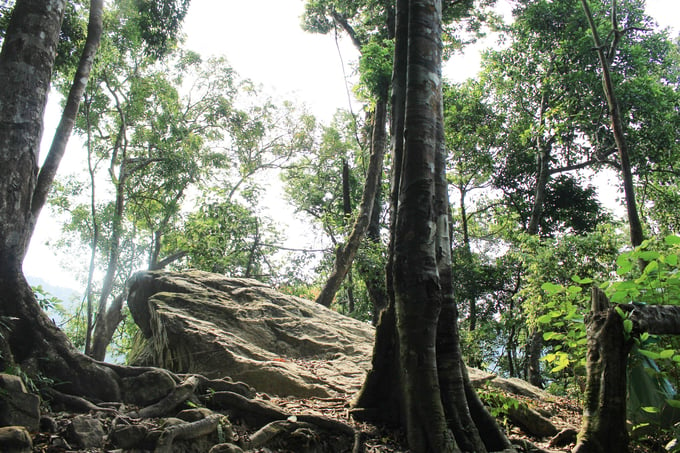
Green conifer trees in Phong Nha - Ke Bang forest. Photo: N. Tam.
Many new species of animals and plants have recently been discovered including 2 species of cave scorpions; warblers on limestone mountains; ferns in caves; green conifer trees; orchids; 10 new fish species; 1 strange fish that can swim upstream; 4 reptile species rediscovered after 50 years; horned viper, etc.
A few decades ago, a group of Bru - Van Kieu nomadic people arrived in the land of Phong Nha - Ke Bang. They set up camp on this peaceful land and settled here ever since. Doong village (Tan Trach commune, Bo Trach district) lies isolated between the core zones of Phong Nha - Ke Bang National Park. After three decades, Doong village has grown from 5 small households to a landmark in the middle of the vast mountains and forests.
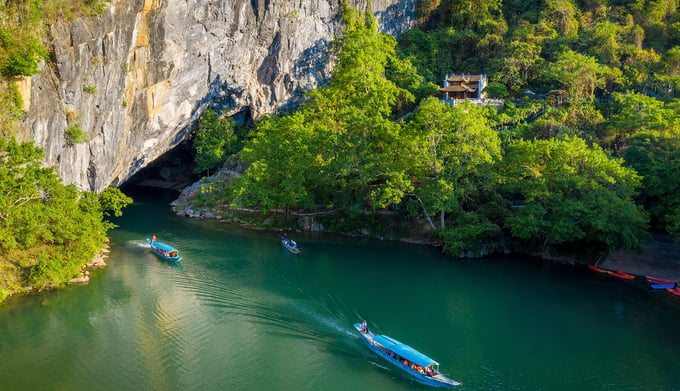
Phong Nha cave gate. Photo: PN-KB.
Doong village currently has 11 households, located in the middle of a valley surrounded by rocky mountains. Mr. Nguyen Soai Trac - the village elder shared: “Doong village is very developed compared to the past. No villager is in poverty, and their children receive education from a very nice school in the village. The village has recently established a Party council".
The Quang Binh provincial government had made multiple attempts at moving Doong village out of the core area of Phong Nha - Ke Bang National Park due to concerns regarding forest protection and environmental protection. The village's custom of hunting and destroying forests for farming is difficult to restrict.
However, the people of Doong village took on the responsibility of preserving the heritage. The village elder recalled: “Firstly, villagers don't raise many dogs anymore. When we were still engaged in hunting, each family had 5 to 7 dogs. No animals could escape from these dogs. They were very smart, knew how to force the animal to run into the trap door that the hunters have set up.”
The villagers promised the village chief to reduce the herd of dogs, and not to bring dogs into the forest. The number of hunting dogs decreased gradually as people reduced their hunting activities in the forest to hunt until the "hunting team" and the dogs were dispersed. People in the "hunting team" now only go into the forest to protect the trees or collect tobacco leaves.
Mr. Nguyen Van Dai, Secretary of the Party Committee of Tan Trach Commune was pleased about the change in the mindset as well as the lives of the Doong villagers. They remain faithfully attached to the forest. The village is more confident when the Government designated 800 hectares of forest for protection. "Raising forests for livelihood. The source of income from preserving the trees of the forest has improved many villagers' lives," said Mr. Dai.
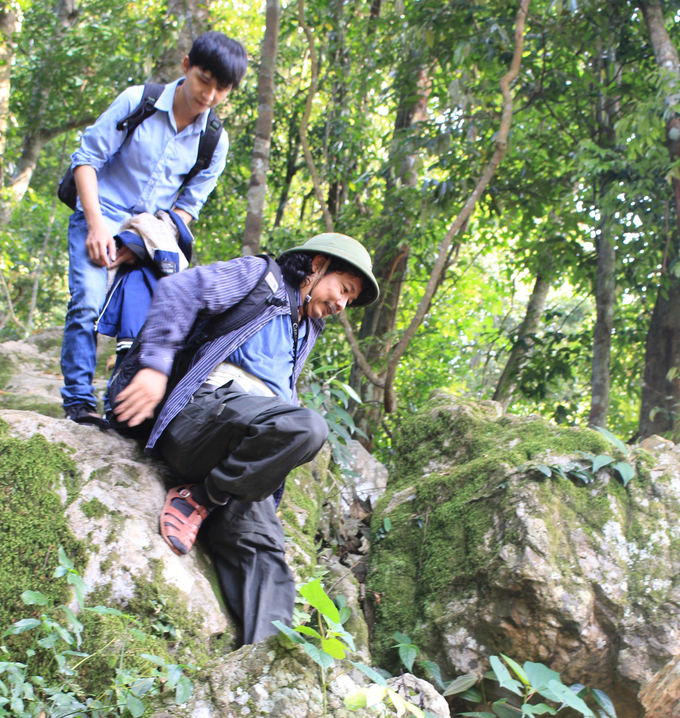
The road to Doong village. Photo: N.Tam.
Doong villagers have converted from from hunting, deforestation for farming to wet rice cultivation, irrigation to expand the area of wet rice cultivation in order to have enough food year round. When they produced a grain of rice, the village elder brought young villagers cross the rocky mountains to Phong Nha town to see farmers milling rice by machine. The young villagers enjoyed the sight so much that the village elder agreed to buy a milling machine for the village without hesitation. Two days later, the bright red milling machine was installed in the hut next to the chief's house on stilts. At the time, not many lowland countryside could afford an oil-powered rice milling machine like the one in Doong village.
The village also focused on tourism development in addition to rice production and milling. When the Oxalis Tourist Company put the Son Doong cave exploration route into operation, the village became a transit point for visitors traveling through the area. The residents of Doong village quickly caught up with this new wave of visitors. With the development of tourism, Doong village is not only an ideal getaway for domestic tourists but also an attractive destination for foreign tourists. The village maintains its own cultural identity and new values are added when the village is connected with the world.
To Mr. Pham Hong Thai, the motto 'prevention is key, protecting the forest from the root' is essential for the ranger force to preserve the heritage forest. Mr. Hoang Van Tam, Head of the Phong Nha - Ke Bang National Park Forest Protection Department, said: “The park ranger constantly keeps 13 core groups on duty at the forest gate and in crucial locations around the clock. On average, we deploy around 2,300 patrols and forests control forces every year, covering a distance of 17,000 to 20,000 kilometers."
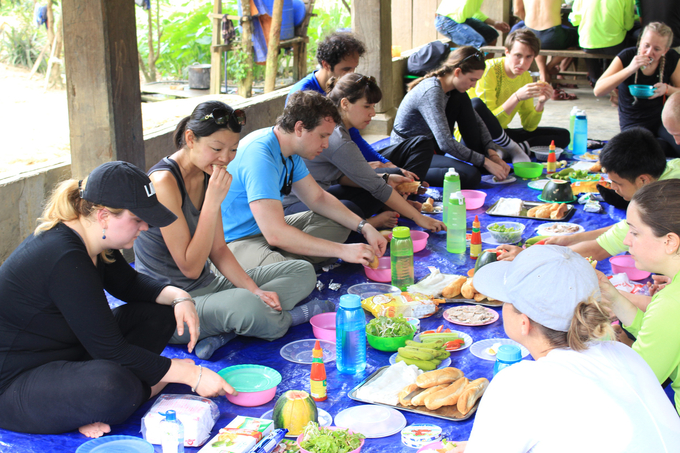
Foreign tourists interacting with the people of Doong village. Photo: N. Tam.
According to Mr. Thai, biological conservation and development for Phong Nha - Ke Bang World Natural Heritage are another topic of interest for the Park Management Board. Wild animals and plants are precious natural resources in the region that contribute significantly to the ecological balance. The staff of the Center for Biological Rescue, Conservation and Development works tirelessly to protect and conserve wild plants and animals.
Mr. Le Thuc Dinh - Director of the Center shared: "Those who rescue and care for wildlife always face the risk of being attacked by animals, or a source of disease transmission. But with a passionate love for wild animals and plants, the Center's staff always devote all their efforts to rescuing, protecting wild animals and plants as well as reintegrating them into the natural environment".
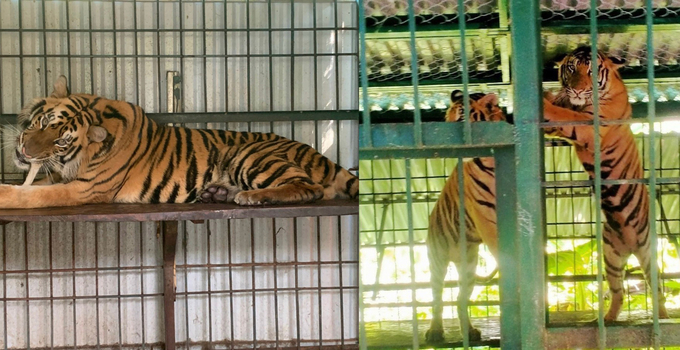
Tigers raised in Phong Nha - Ke Bang National Park. Photo: N. Tam.
The mountains and forests of Phong Nha - Ke Bang seemed to stir when the park director decided to adopt and nurture 7 tigers. For over a year, the staff at the Center for Biological Rescue, Conservation and Development carefully nurtured and bonded with the tigers who are in the healthy and developing age. The initial worries were gradually eased when all 7 tigers became stronger and more mature.
Mr. Pham Hong Thai said: “We have successfully implemented the first part of this tiger breeding project. Subsequently, the tigers will be moved to a semi-wild breeding area where visitors can watch the tigers as if they are living in the natural environment". Whenever the sun rises or sets, the tigers roar mightily amidst the noise of the mountains and forests. The roar seems to bolster this sacred sensation of the majestic Phong Nha mountains.
Translated by Nguyen Hai Long
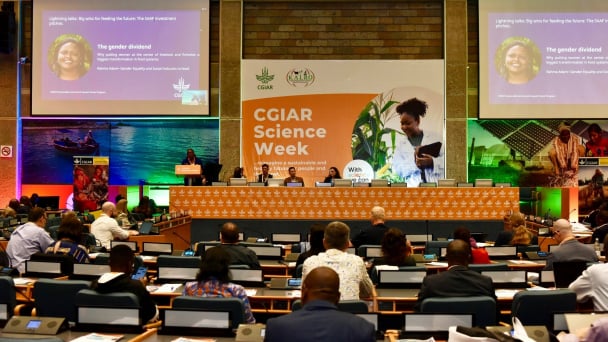
(VAN) The CGIAR’s Sustainable Animal and Aquatic Foods (SAAF) program represents a new approach that emphasizes the transformation of food systems toward sustainability.
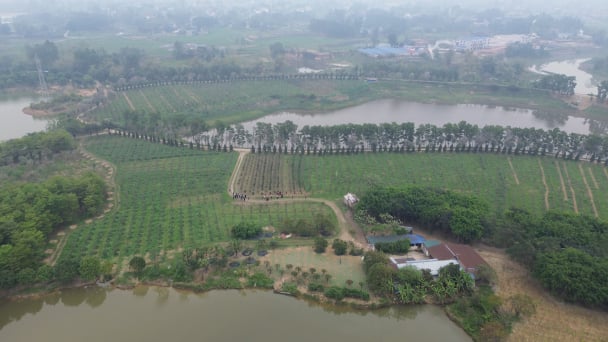
(VAN) Scientists assume that industrial agriculture has been 'outdated.' As a result, a comprehensive overhaul or a revolution in the direction of embracing ecological agriculture is needed.
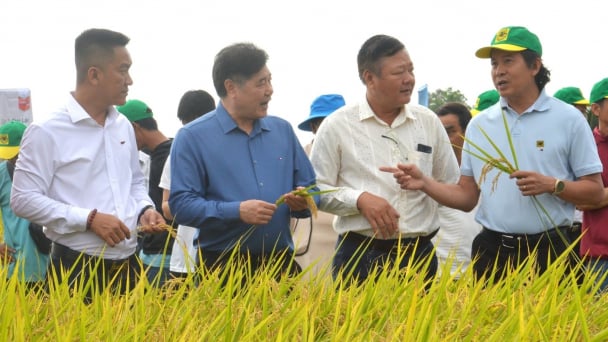
(VAN) The results from pilot fields are catalyzing the expansion of the One million hectares of high-quality, low-emission rice project in Kien Giang.
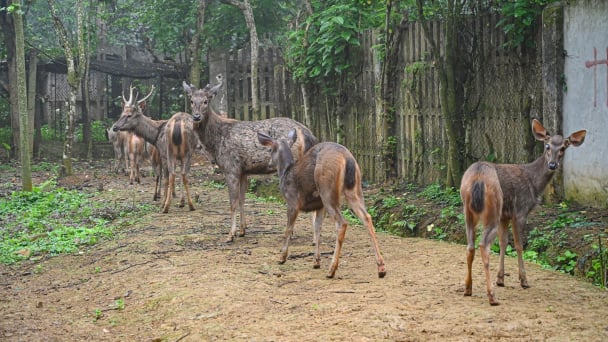
(VAN) On the morning of April 11, Cuc Phuong National Park received 18 individuals of endangered and rare wild animals from Da Nang city.
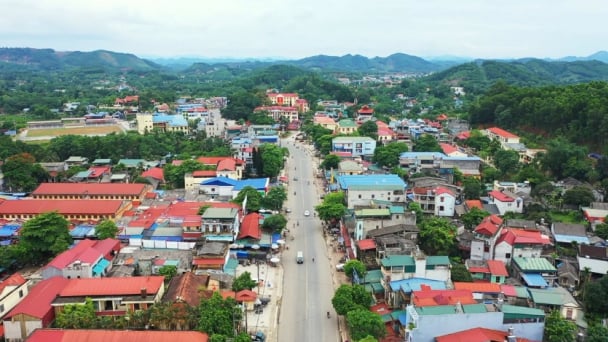
(VAN) FAO supports Vietnam in enhancing survey sampling techniques for the 2025 nationwide agricultural and rural census.
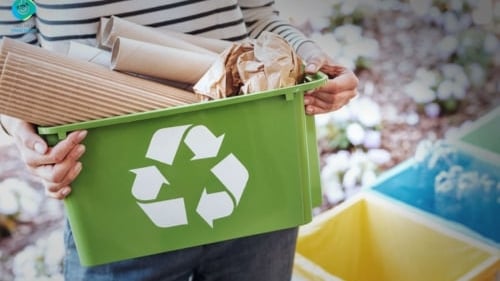
(VAN) By participating in the green transition, manufacturers become an indispensable part of the circular economy, contributing to resource optimization and environmental protection.

(VAN) The One Million Hectares of High-Quality and Low-Emission Rice Program can generate nearly 14 million tons of straw annually, posing an urgent requirement to diversify straw-based products.